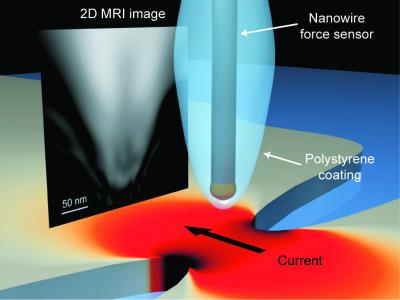A team from the University of Illinois at Urbana-Champaign and Northwestern University has devised a novel nuclear magnetic resonance imaging (MRI) technique that delivers a roughly 10¬nanometer spatial resolution. This represents a significant advance in MRI sensitivity — modern MRI techniques commonly used in medical imaging yield spatial resolutions on the millimeter length scale, with the highest-resolution experimental instruments giving spatial resolution of a few micrometers.
“This is a very promising experimental result,” said U. of I. physicist Raffi Budakian, who led the research effort. “Our approach brings MRI one step closer in its eventual progress toward atomic-scale imaging.”
MRI is used widely in clinical practice to distinguish pathologic tissue from normal tissue. It is noninvasive and harmless to the patient, using strong magnetic fields and non-ionizing electromagnetic fields in the radio frequency range, unlike CT scans and tradiational X-rays, which both use more harmful ionizing radiation.
MRI uses static and time-dependent magnetic fields to detect the collective response of large ensembles of nuclear spins from molecules localized within millimeter-scale volumes in the body. Increasing the detection resolution from the millimeter to nanometer range would be a technological dream come true.
The team’s breakthrough — the new technique introduces two unique components to overcome obstacles to applying classic pulsed magnetic resonance techniques in nanoscale systems. First, a novel protocol for spin manipulation applies periodic radio-frequency magnetic field pulses to encode temporal correlations in the statistical polarization of nuclear spins in the sample. Second, a nanoscale metal constriction focuses current, generating intense magnetic field-pulses.
In their proof-of-principal demonstration, the team used an ultrasensitive magnetic resonance sensor based on a silicon nanowire oscillator to reconstruct a two-dimensional projection image of the proton density in a polystyrene sample at nanoscale spatial resolution.
“We expect this new technique to become a paradigm for nanoscale magnetic-resonance imaging and spectroscopy into the future,” added Budakian. “It is compatible with and can be incorporated into existing conventional MRI technologies.”
If our reporting has informed or inspired you, please consider making a donation. Every contribution, no matter the size, empowers us to continue delivering accurate, engaging, and trustworthy science and medical news. Independent journalism requires time, effort, and resources—your support ensures we can keep uncovering the stories that matter most to you.
Join us in making knowledge accessible and impactful. Thank you for standing with us!


this is a whole lot more than just MRI scans…
IMO, this is the human to computer thought predictive and context predictive interface input system for the short term future
but it also means giving up some amusements, here and there.
the robot dude in your video game will no longer ask “what?”, when you ask, “you know what?”
and said robot will also know not to pull your finger when you ask him to pull your finger, and he’ll know WHY he shouldn’t pull your finger.
IMO, acceptable tradeoff for computing at the speed of thought.
peace